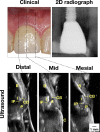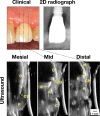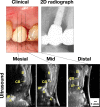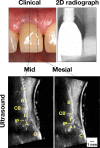Ultrasonography for diagnosis of peri-implant diseases and conditions: a detailed scanning protocol and case demonstration
- PMID: 32017634
- PMCID: PMC7549532
- DOI: 10.1259/dmfr.20190445
Ultrasonography for diagnosis of peri-implant diseases and conditions: a detailed scanning protocol and case demonstration
Abstract
Objectives: Ultrasonography has shown its promising diagnostic value in dental implant imaging research in the three treatment phases, namely, planning, intraoperative, and postoperative phase. With increasing awareness of peri-implant diseases and a lack of an efficient diagnostic method, the aim is to propose ultrasound imaging as a potential solution by providing a detailed scanning protocol and case demonstration.
Methods: Ultrasound device specification and the setup for optimizing peri-implant tissue imaging was described. Two useful imaging modes, viz. B-mode and color flow, were introduced. Important anatomical structures for accurate diagnosis of peri-implant diseases were illustrated. Finally, a detailed scanning sequence was proposed.
Results: Ultrasound images were acquired on live humans to exemplify the four peri-implant diseases and conditions, endorsed by the 2017 World Workshop organized by the American Academy of Periodontology and the European Federation of Periodontology. Ultrasound can provide not only cross-sectional anatomical images but also functional images (color flow images) that may be useful for evaluating the degree of peri-implant tissue inflammation.
Conclusions: High-frequency ultrasonography could be another cross-sectional imaging modality in adjunct to radiographs for diagnosing imminent peri-implant diseases and conditions that negatively influence quality of life of millions of patients with implants. This case study provides a framework for future related research work and clinical scanning guidelines.
Keywords: alveolar bone; cone-beam computed tomography; dental Implants; peri-implantitis; soft tissue; ultrasonography.
Figures






